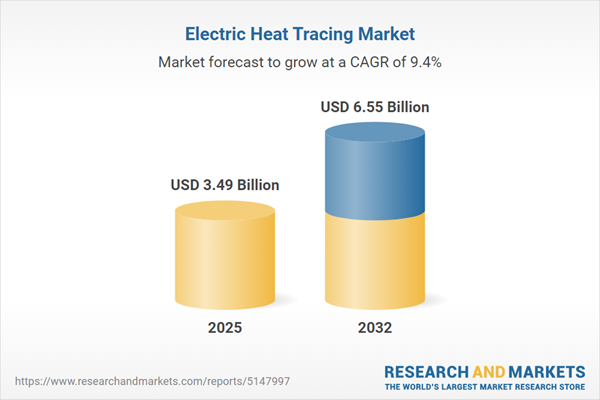Speak directly to the analyst to clarify any post sales queries you may have.
The electric heat tracing market is experiencing steady evolution as industrial leaders pursue enhanced reliability, data-driven operations, and improved risk management in critical facility environments. Senior executives recognize electric heat tracing as an enabler of resilient infrastructure, supporting compliance objectives and driving operational efficiency across diverse sectors.
Electric Heat Tracing Market Snapshot
The electric heat tracing market is currently valued at USD 3.19 billion and is projected to grow to USD 3.49 billion by 2025, delivering a compound annual growth rate of 9.40% through 2032. Demand for electric heat tracing solutions is driven by their adoption across chemicals, energy, and refining sectors, as enterprises address mounting regulatory pressures and higher standards for operational safety. Growth is supported by increasing uptake not only in established but also in emerging regions, making electric heat tracing a vital technology for organizations balancing compliance, cost management, and performance requirements. The integration of digital control systems is reshaping the landscape, allowing real-time asset monitoring and reduced maintenance needs while ensuring business continuity in dynamic industrial conditions.
Scope & Segmentation of the Electric Heat Tracing Market
Senior decision-makers benefit from a clear understanding of the structural drivers and segment diversity within the electric heat tracing market. Detailed segmentation highlights opportunities to strategically align infrastructure investments and operational strategies for optimal results.
- System Types: Includes constant wattage for consistent performance, mineral insulated for extended service in hazardous areas, and self-regulating systems that adjust output based on process changes for optimal safety and operating efficiency.
- Applications: Solutions are engineered for floor warming in commercial settings, freeze protection for exposed assets like pipelines, and roof or gutter de-icing, each enhancing asset safety and longevity.
- End User Industries: Core sectors using electric heat tracing include chemicals, petrochemicals, oil and gas (onshore and offshore installations), construction, and food and beverage, with each achieving minimized production risk and improved uptime.
- Temperature Ranges: Products are designed for broad thermal management, addressing requirements from low-temperature asset protection to rigorous, high-temperature industrial processes.
- Installation Modes: Options include new deployments, system upgrades, retrofits for legacy facilities, and integration during expansion projects, accommodating a spectrum of project needs and timelines.
- Regional Coverage: Markets across the Americas, Europe, Middle East and Africa, and Asia-Pacific reflect variable regulatory landscapes and investment priorities, influencing global procurement patterns for heat tracing technology.
- Leading Companies: Notable providers such as nVent Electric plc, Thermon Group Holdings, Pentair plc, ABB Ltd, Danfoss A/S, Watlow Electric Manufacturing Company, Fujikura Ltd, BriskHeat Corporation, EHT Holding GmbH, and General Cable Technologies Corp deliver specialized solutions to a global client base.
Key Takeaways for Senior Decision-Makers
- Electric heat tracing enables integration with new and existing infrastructure, supporting organizations to meet changing compliance requirements.
- IoT-enabled automation and advanced diagnostics facilitate real-time monitoring, drive predictive maintenance, and help reduce the risk of unexpected downtime for critical assets.
- Digital monitoring systems accelerate fault detection and response, which strengthens operational resilience and reduces delay risk.
- Implementing standardized management frameworks ensures scalable, robust system performance even as regulatory and operational needs evolve.
- Procurement strategies are influenced by regional context, with mature markets focusing on modernization for compliance and emerging markets prioritizing scalable, growth-oriented solutions.
- Collaboration with energy and digital solution providers increases reliability, especially in remote or complex environments where timely maintenance can be challenging.
Tariff Impact: Navigating Trade and Supply Chain Dynamics
With anticipated U.S. tariff adjustments in 2025, organizations are diversifying their supplier bases and bolstering domestic manufacturing to mitigate import risks. Reviewing facility locations and supply chains enhances resilience and secures consistent access to essential electric heat tracing components, supporting sector stability during periods of trade policy change.
Methodology & Data Sources
This report’s guidance is built on insights from executive interviews and comprehensive secondary research, incorporating international regulations, vendor documentation, and technical standards. The methodology ensures actionable guidance for senior leaders overseeing strategic planning, procurement, and compliance in the electric heat tracing sector.
Why This Electric Heat Tracing Market Report Matters
- Delivers clear, actionable insights on procurement, digital transformation, and regulatory trends shaping the electric heat tracing industry.
- Supports organizations in strengthening sourcing and risk mitigation approaches to navigate market transitions and compliance shifts.
- Enables leaders to make fact-based, future-ready decisions with analytical clarity tailored to operational and regulatory objectives.
Conclusion
Electric heat tracing is an essential lever for advancing digital infrastructure, securing operational reliability, and achieving compliance objectives. Organizations equipped with these insights are prepared to enhance resilience and adapt to changing industrial demands.
Additional Product Information:
- Purchase of this report includes 1 year online access with quarterly updates.
- This report can be updated on request. Please contact our Customer Experience team using the Ask a Question widget on our website.
Table of Contents
3. Executive Summary
4. Market Overview
7. Cumulative Impact of Artificial Intelligence 2025
Companies Mentioned
The companies profiled in this Electric Heat Tracing market report include:- nVent Electric plc
- Thermon Group Holdings, LLC
- Pentair plc
- ABB Ltd
- Danfoss A/S
- Watlow Electric Manufacturing Company
- Fujikura Ltd
- BriskHeat Corporation
- EHT Holding GmbH
- General Cable Technologies Corp
Table Information
| Report Attribute | Details |
|---|---|
| No. of Pages | 196 |
| Published | October 2025 |
| Forecast Period | 2025 - 2032 |
| Estimated Market Value ( USD | $ 3.49 Billion |
| Forecasted Market Value ( USD | $ 6.55 Billion |
| Compound Annual Growth Rate | 9.4% |
| Regions Covered | Global |
| No. of Companies Mentioned | 11 |









